Deep sky objects
Albireo (Beta Cygni) (2021-05-28)
Albireo (Beta Cygni)
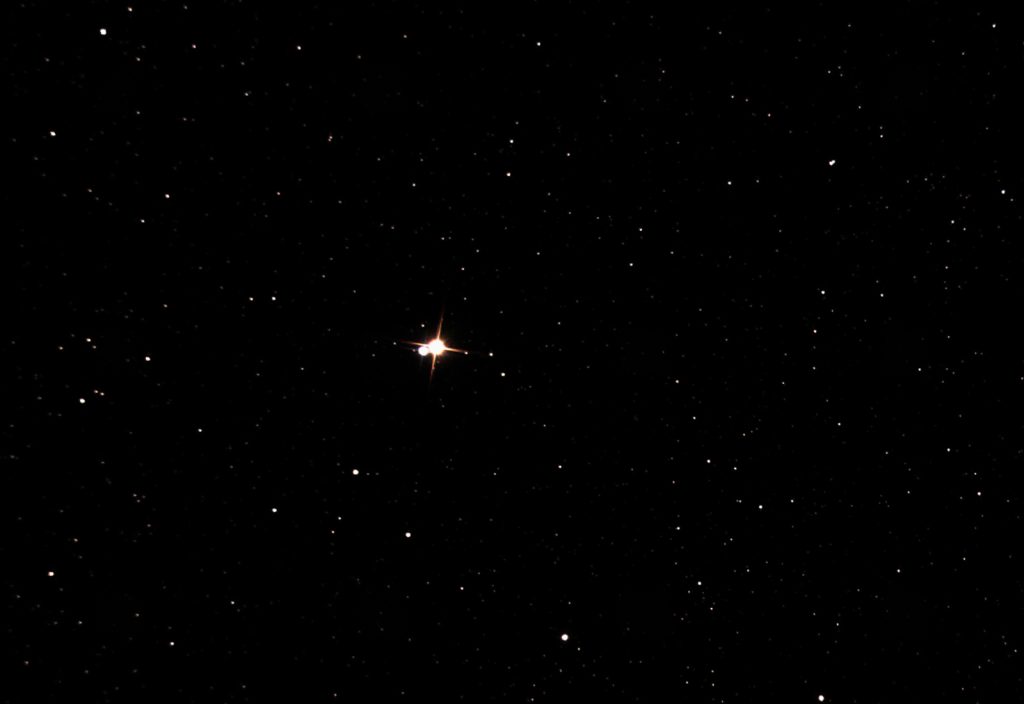
10.1″ f/4.5, Mallincam DS432cTEC, single frame snapshot with high saturation
Albireo is a beautiful optical binary showcasing a brilliant yellow primary next to a blue secondary star. The two stars are separated by 35 arc seconds, and are 420 light years away.
North at 10 o’clock, East at 7 o’clock
IC 434 (2023-01-14)
IC 434
Horsehead Nebula in Orion
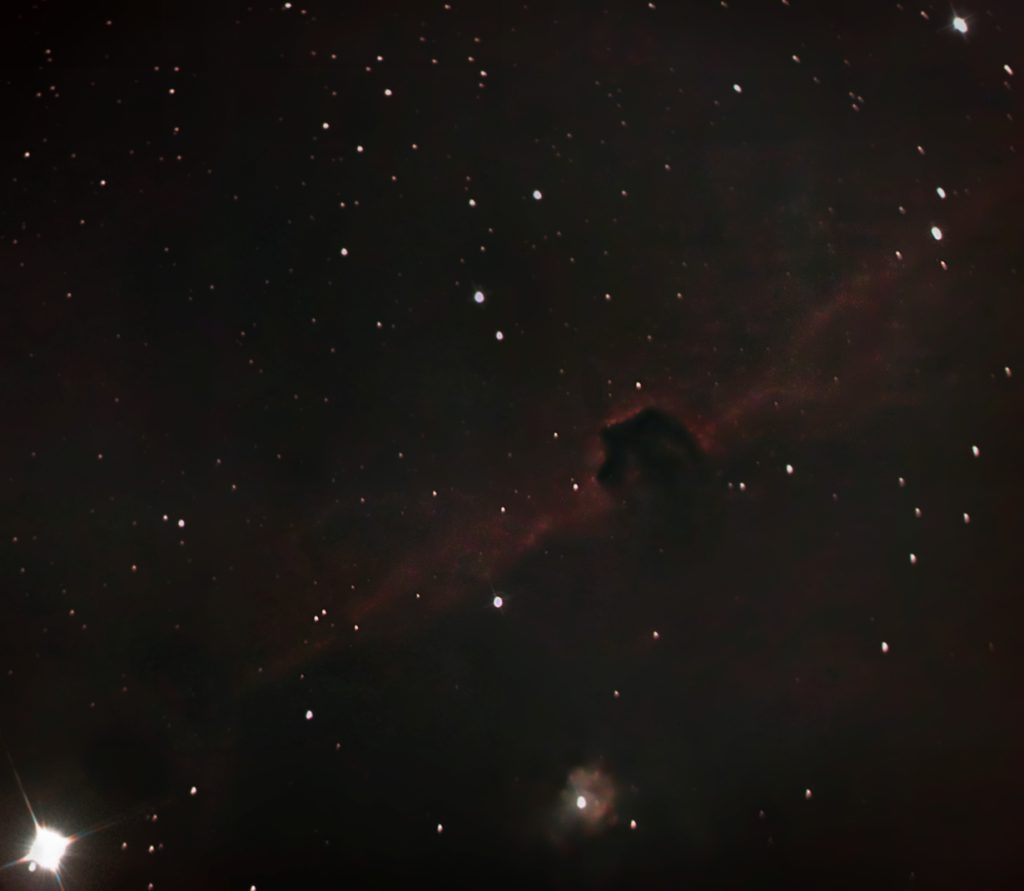
10.1″ f/4.5, Mallincam DS432cTEC with 0.5 focal reducer and Astronomik UHC filter
Exposure = 10 sec, Live Stacked frames = 15, Gain = 33 of 250
The Horsehead Nebula’s (Barnard 33) distinct shape appears quite readily against the ionized hydrogen-red backdrop of IC 434. The dark nebula is about 1400 light years away and 7 light years across. In this relatively quick snapshot (15 frames of 10 second exposures), the length of IC 434 spans about 50 arc minutes, the horsehead appears to be 5 x 4 arc minutes in size.
To the north (bottom-left ) is the bright star Alnitak (Zeta Orionis), which is the left-most star in Orion’s Belt. Alnitak is a hot blue supergiant at magnitude 1.74, about 1260 light years away. Below the Horsehead is the round clump of nebulosity NGC 2023, which is both an emission and reflection nebula and explains why there is a combination of red with blue-green colours reminiscent of the Trifid. NGC 2023 is 1300 light years away and appears to be about 3 x 2 arc minutes across.
North at 7 o’clock, East at 4 o’clock
NGC 654 (2022-06-18)
NGC 654
Fuzzy Butterfly Cluster in Cassiopeia
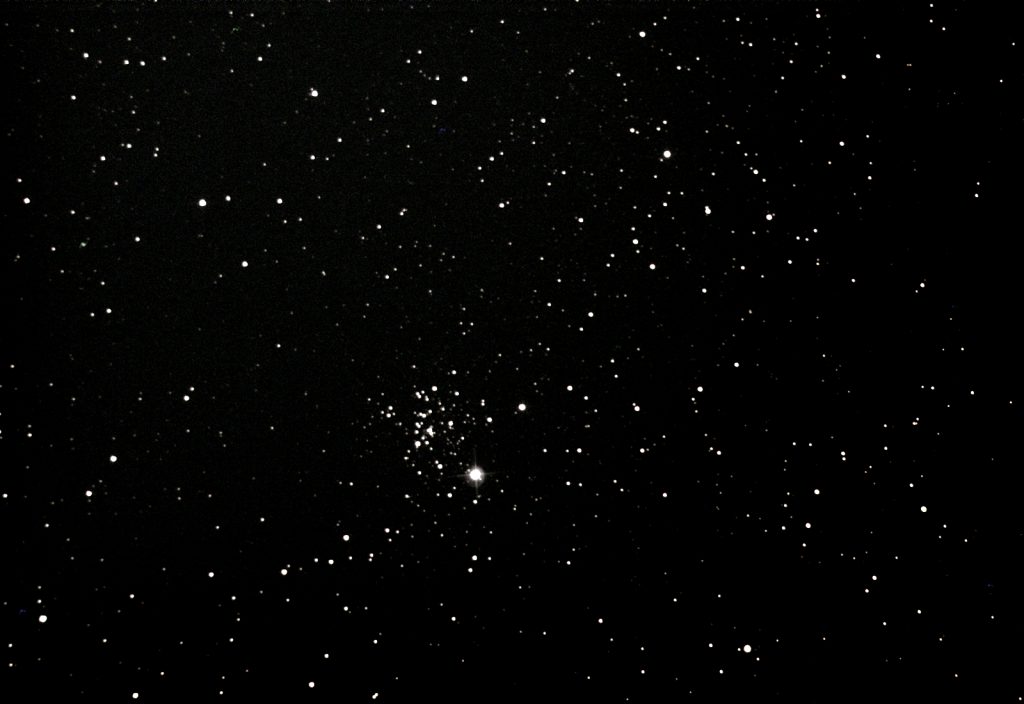
10.1″ f/4.5, Mallincam DS432cTEC with Astronomik UHC filter
Exposure = 2.6 sec, Live Stacked frames = 30, Gain = 72 of 250
A pretty little cluster that stands out well against the background sky with a wedge-shaped core of densely-packed stars and a bright magnitude 7.3 yellow supergiant on the south-east corner. The cluster is relatively far, over 7800 light years away in the Perseus Arm of the Milky Way. North and east of the cluster runs a dark “river” of dust that appears in long-exposure photographs.
North at 9 o’clock, East at 6 o’clock
NGC 869 & 884 (2021-09-01)
NGC 869 & 884
Double Cluster (Eta and Chi Persei) in Perseus
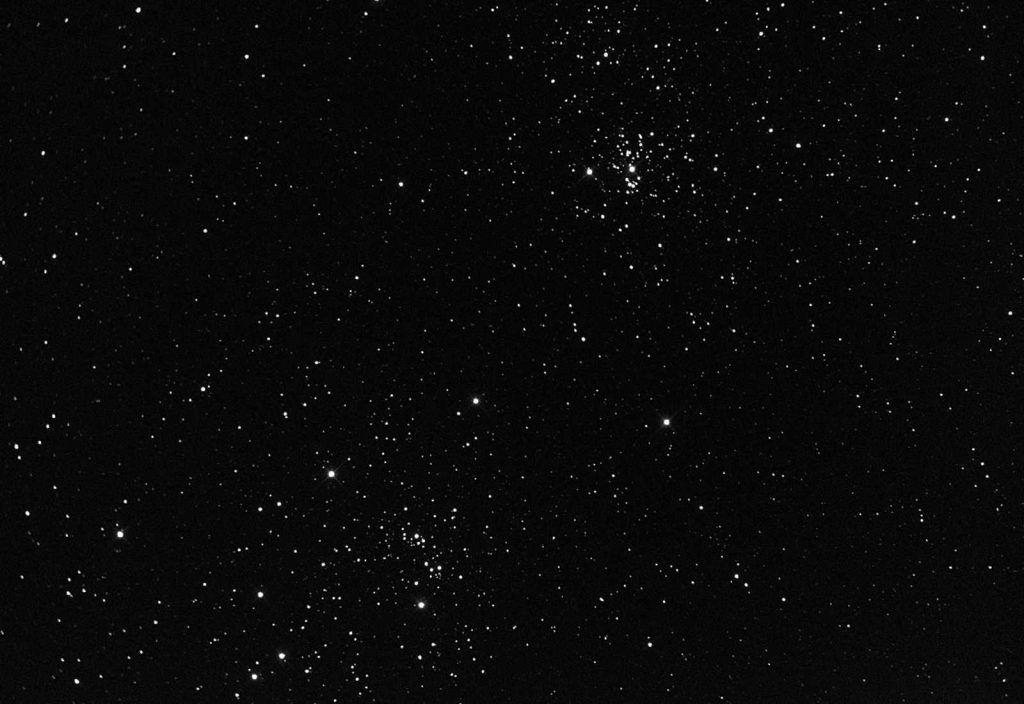
10.1” f/4.5, Mallincam DS432cTEC with 0.5 focal reducer
Exposure = 2 sec, Live-stacked frames = 1, Gain = 30 of 250
A beautiful star field, too many to count! The eastern-most cluster NGC 884 (chi, at bottom) is slightly dimmer and less compact than the western cluster NGC 869 (eta, at top). Estimate about a 1/2 degree between the two clusters; they lie about 7,500 light years away in the Perseus Arm of the Milky Way galaxy.
North at 10 o’clock, East at 7 o’clock
more images..
IC 1805 (2022-07-22)
IC 1805
Heart Nebula in Cassiopeia
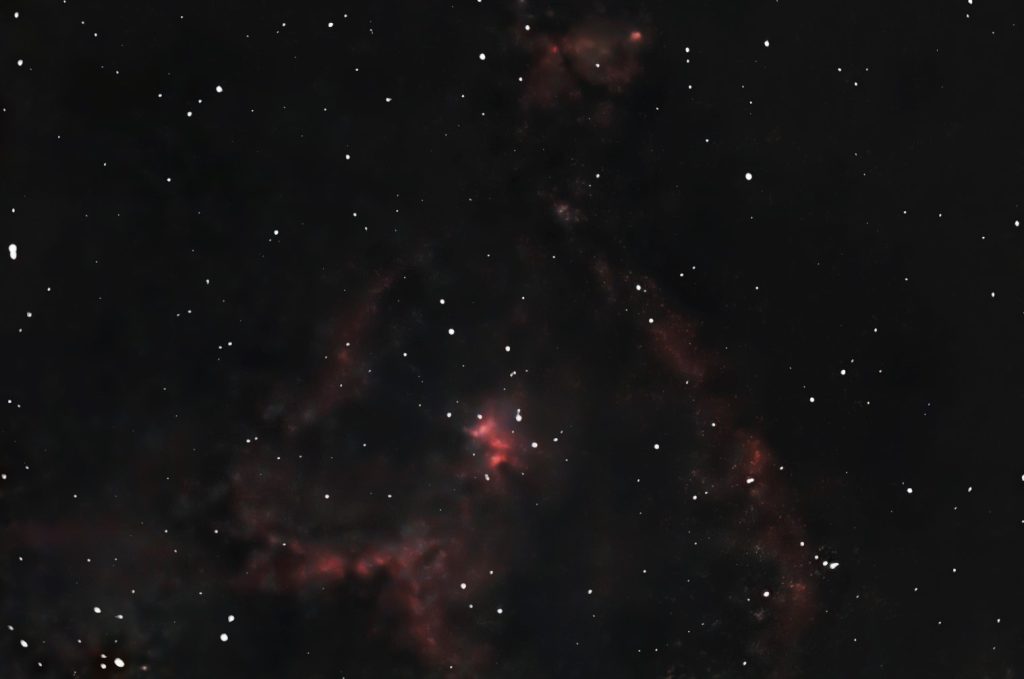
80mm f/5, Mallincam DS432cTEC with 0.5 focal reducer and Astronomik UHC filter
Exposure = 10-25 sec, Live Stacked frames = 15-65 (80 total), Gain = 40 of 250
Located in the Perseus Arm of the Milky Way, the Heart Nebula is a very large and diffuse object spanning some two and a half degrees in the sky. The Heart is about 7500 light years away and is quite large at over 300 light years across. The open cluster of stars at the center is Collinder 26 and is what powers the glowing hydrogen (red) and sulphur (orange) in the nebula. The nebular patch at the very top of the image is called the Fish Head Nebula (NGC 896). Due to the size of the Heart / Fish Head, I used the 80mm scope with focal reducer to try to get most of it in the field of view, which is approximately 2 by 3 degrees here.
North at 10 o’clock, East at 7 o’clock
NGC 2237, NGC 2238, NGC 2244, and NGC 2246 (2023-02-14)
NGC 2237-8, 44, 46
Rosette Nebula in Monoceros
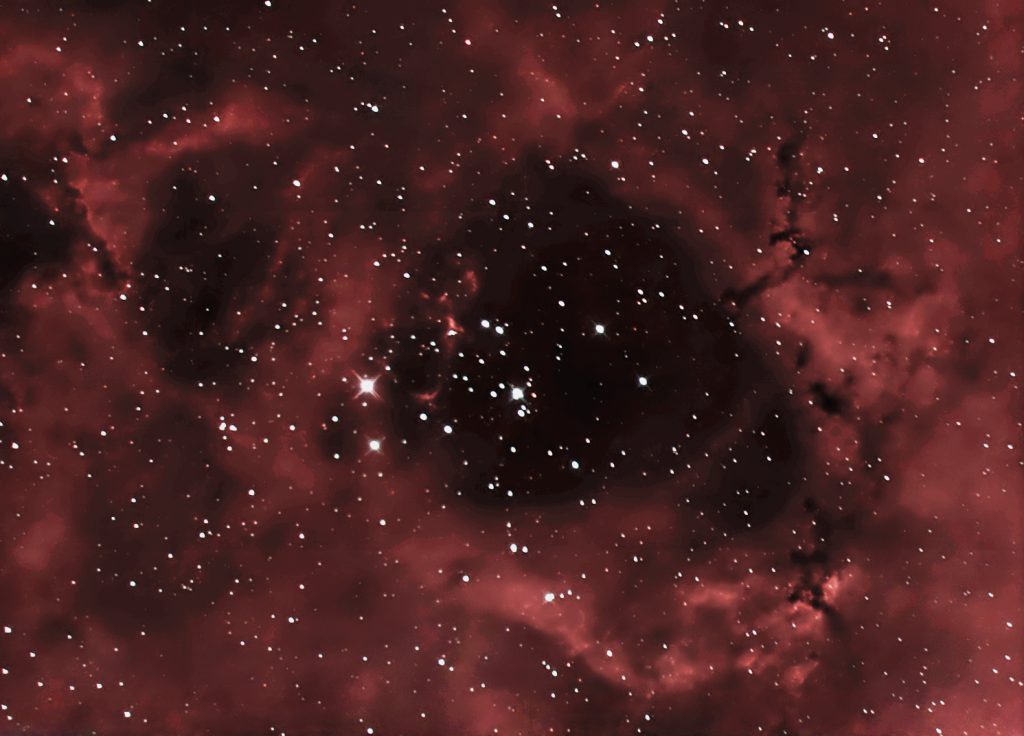
10.1″ f/4.5, Mallincam DS432cTEC with 0.5 focal reducer and Optolong L-eNhance filter
Exposure = 10-15-20 sec, Live Stacked frames = 15-15-15 (45 total), Gain = 40 of 250
The Rosette Nebula, also known as Caldwell 49, is a very large diffuse galactic nebula, about 1.3 degrees across in the sky and 115 light years in size. According to O’Meara, it is located twice as far as the Orion Nebula (modern listing has it at 5200 light years vs. 1350 for the Orion Nebula) yet appears roughly the same in size which demonstrates the enormity of the cloud. This nebula was discovered in pieces, first by William Herschel; NGC 2237 and 38 form the western flank, while NGC 2244 forms the eastern. Astronomers theorize the dark space at center is an area where dust has been blown away by the high velocity solar winds of newly formed energetic stars.
NGC 2246 (Caldwell 50) is the brilliant cluster at center, with its brightest member 6th magnitude 12 Monocerotis, which is actually a foreground star 518 light years away. The cluster is about 18 light years across and is primarily composed of a couple of dozen 7th to 9th magnitude suns spanning some 20 arc minutes; the major shape is a couple of rows of 3 bright pairs in the center of the view. Burnham’s lists it as “very large, bright, little compressed.”
North at 2 o’clock, East at 11 o’clock
NGC 4627 & 4631 (2023-05-13)
NGC 4627 & 4631
The Whale Galaxy in Canes Venatici
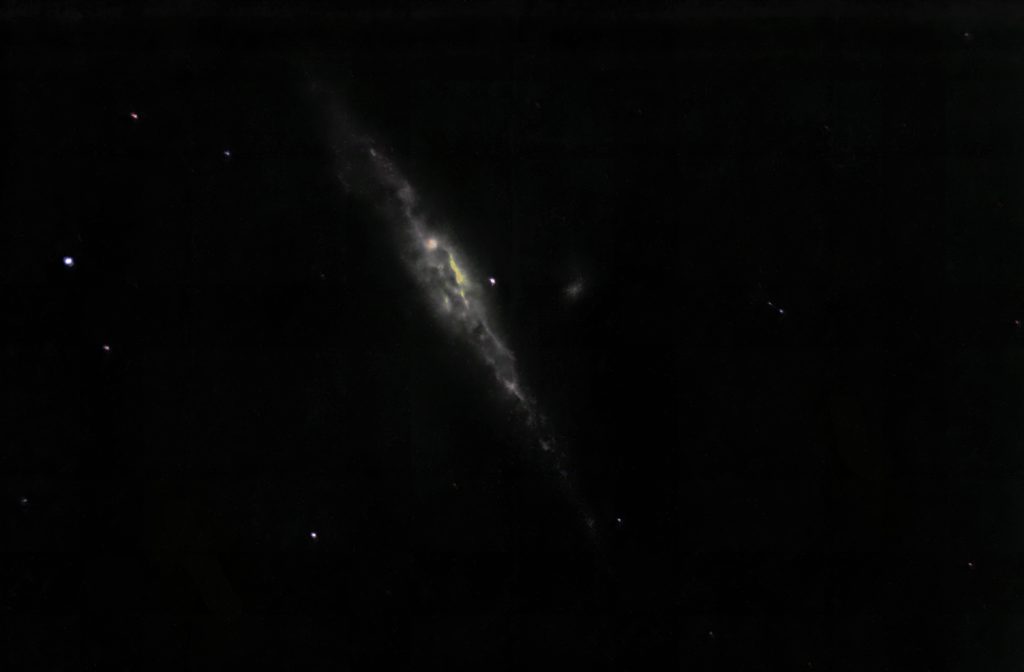
10.1″ f/4.5, Mallincam DS432cTEC with 1.5x Barlow
Exposure = 10-15 sec, Live Stacked frames = 15-25, Gain = 22 of 250
NGC 4631 the Whale Galaxy, also known as Caldwell 32, is a long and bright 10th magnitude barred-spiral. In this image the Whale appears about 10 arcminutes long by 2 arcminutes wide, lying 30 million light years away. Locating the Whale was relatively straightforward with high gain / short exposure video; a couple of stacks of 10 and 15 second exposures captures a wealth of detail in the data, as seen here. Wispy dark dust clouds obscure the brighter regions of the galactic core seen edge-on. A 12th magnitude star lies just above the north rim of the galaxy; west (lower right) of the core a 14th magnitude star appears at the westerly extent of the arms. I don’t think there are many galaxies in the sky that compare to the amount of detail this one provides.
The faint small patch of light to the right of the Whale is NGC 4627, a companion dwarf elliptical galaxy.
North at 2 o’clock, East at 11 o’clock
IC 5070 (2022-07-08)
IC 5070
Pelican Nebula in Cygnus

10.1″ f/4.5, Mallincam DS432cTEC with 0.5 focal reducer and Astronomik UHC filter
Exposure = 10-15-20-25 sec, Live Stacked frames = 20-20-20-20 (80 total), Gain = 50 of 250
The Pelican Nebula is a large 1.5 degree-wide structure that is just off the eastern “coast” of the North America Nebula, which is off the left edge of this field of view. Seen here, the “head” of the Pelican is pointed straight up, with the beak and neck curving down in a red-orange cascading nebular structure that is about 10 light years in length, which itself is labeled IC 5067. There are many dark rifts and patches along this stretch, clouds of cool gas and dust that punctuate the brighter lit regions of hydrogen (red), sulfur (orange), and oxygen (blue-green). In some ways those cuts of darkness kind of look similar to a complex coastline of fjords. The two bright stars at the lower left and right corners of the image (having halos, optical artifacts of the Astronomik UHC filter) are 57 Cygni and 56 Cygni, magnitudes 4.8 and 5.1 respectively. The Pelican is about 2000 light years away.
North at 11 o’clock, East at 8 o’clock
IC 5146 (2022-06-25)
IC 5146
Cocoon Nebula in Cygnus
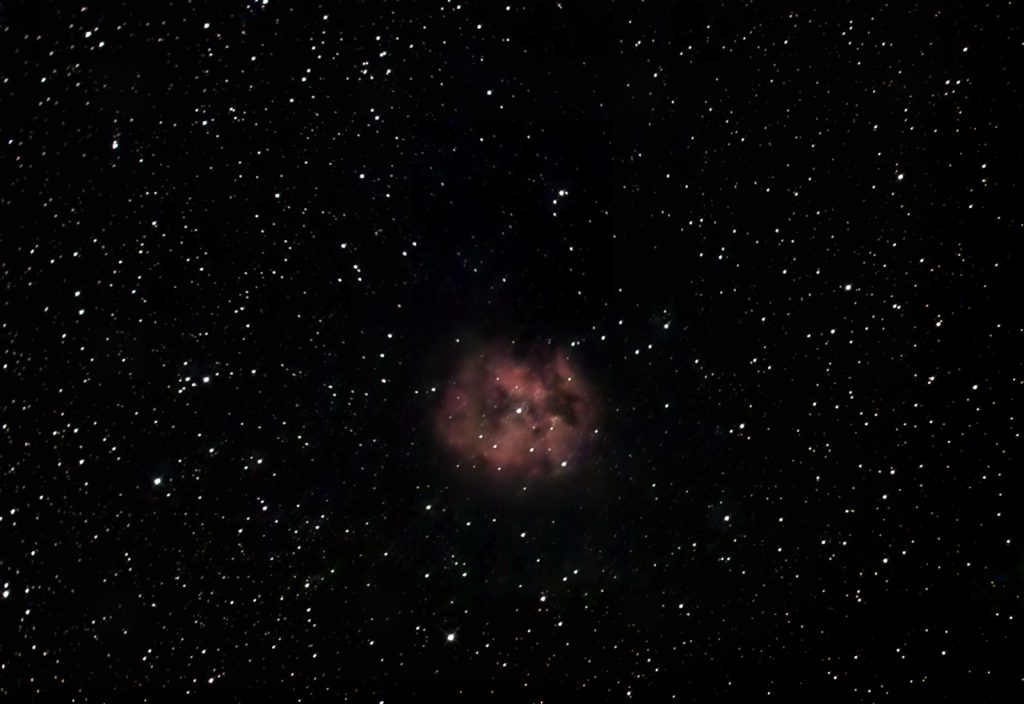
10.1″ f/4.5, Mallincam DS432cTEC with 0.5 focal reducer and Astronomik UHC filter
Exposure = 5-13-20 sec, Live Stacked frames = 20-25-30 (75 total), Gain = 70 of 250
Also known as Caldwell 19 and the Cocoon Nebula, IC 5146 is an emission and reflection nebula about 15 light years across and 2500 light years away. The shape of the nebula along with the dark lanes and patches cutting across its face have drawn comparisons to another more famous emission/reflection nebula, the Trifid. Perhaps one of the most notable aspects of the Cocoon is how it is encircled by a darker nebula, Barnard 168, which appears to also flow westward (up) in this view and is evident by the significant lack of stars. Barnard 168 makes it look like the Cocoon is enveloped in a dark tear-drop.
North at 10 o’clock, East at 7 o’clock
NGC 5746 (2022-06-18)
NGC 5746
Mini Sombrero Galaxy in Virgo

10.1″ f/4.5, Mallincam DS432cTEC with Astronomik UHC filter
Exposure = 15-29 sec, Live Stacked frames = 25-15 (40 total), Gain = 25-40 of 250
Also known as the Blade and Pearl Galaxy, NGC 5746 is a spiral that we see nearly edge-on, appearing about 5 arcminutes long in this image. A least three foreground stars are superimposed on the lower edge. Hints of a dark lane are visible on the north side of the disk. The bright star to the left is 109 Virginis, a 3.7 magnitude star 134.5 light years away that forms one of the “feet” of the constellation Virgo. NGC 5746 is 95 million light years away.
North at 1 o’clock, East at 10 o’clock
NGC 6822 (2022-06-18)
NGC 6822
Barnard’s Galaxy in Sagittarius
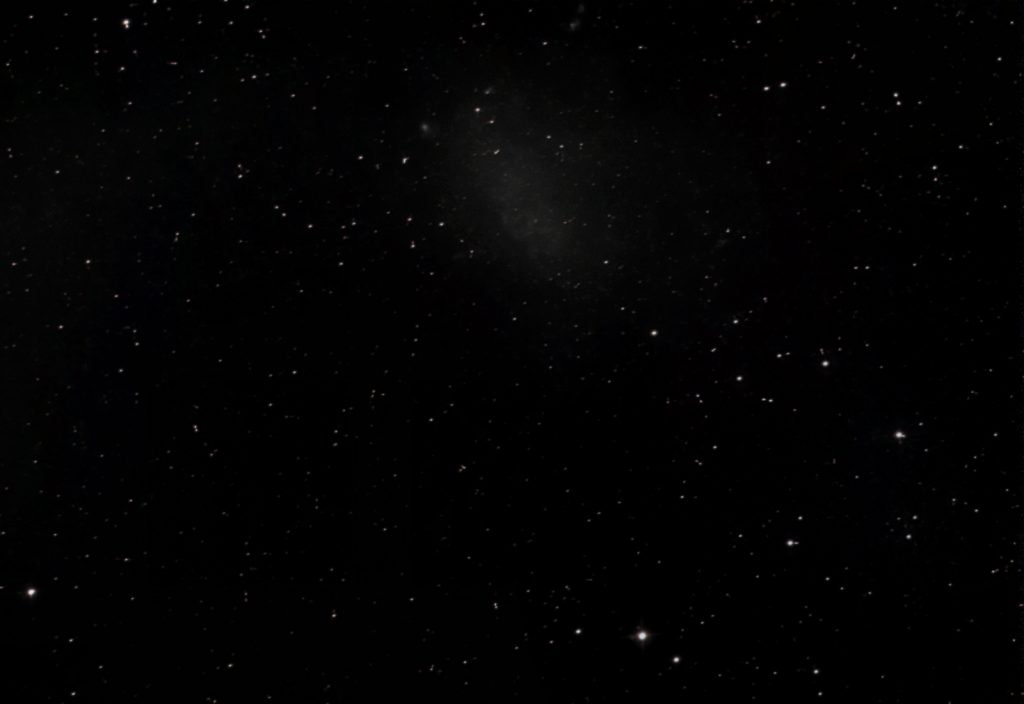
10.1″ f/4.5, Mallincam DS432cTEC with Astronomik UHC filter
Exposure = 13 sec, Live Stacked frames = 60, Gain = 70 of 250
Barnard’s is a dwarf irregular galaxy lying 1.6 million light years away, or two-thirds the distance to the Andromeda Galaxy. It is a member of the Local Group and very similar in size to the Small Magellanic Cloud (7000 light years across), but due to its distance is much smaller and appears very faint in the sky, so faint that I could not immediately see it in the Mallincam. Trusting the location identified in my Nexus DSC, after 15-20 stacks of 13 second exposures it started to appear out of the background sky. Several star-forming regions of ionized hydrogen appear at the top of the image as faint green smudges, including the Bubble Nebula and Ring Nebula very faint at the very top-center right edge of the frame. For comparison see this image from ESO, ALMA.
North at 11 o’clock, East at 8 o’clock
NGC 6826
NGC 6826
Blinking Planetary in Cygnus
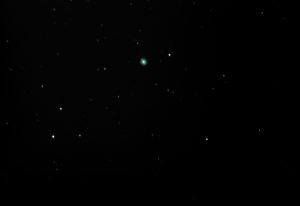

10.1″ f/4.5, Mallincam DS432cTEC with Astronomik UHC filter and 2.5x barlow
Exposure = 5 sec, Live Stacked frames = 45, Gain = 40 of 250
Also known as Caldwell 15, the Blinking Planetary measures 27 arc seconds by 24. In a low-medium power view such as on the left, the striking and beautiful turquoise colour of the small disk stands out distinctly against the background. At higher power as shown above right, more structure within the disk is obvious; an inclined ring-like structure surrounding the bright central region, all within a circular halo. The tips of the rings poke through the halo on either side. NGC 6826 is about 0.2 light years across and 2000 light years away.
North at 9 o’clock, East at 6 o’clock
NGC 6888 (2022-06-25)
NGC 6888
Crescent Nebula in Cygnus
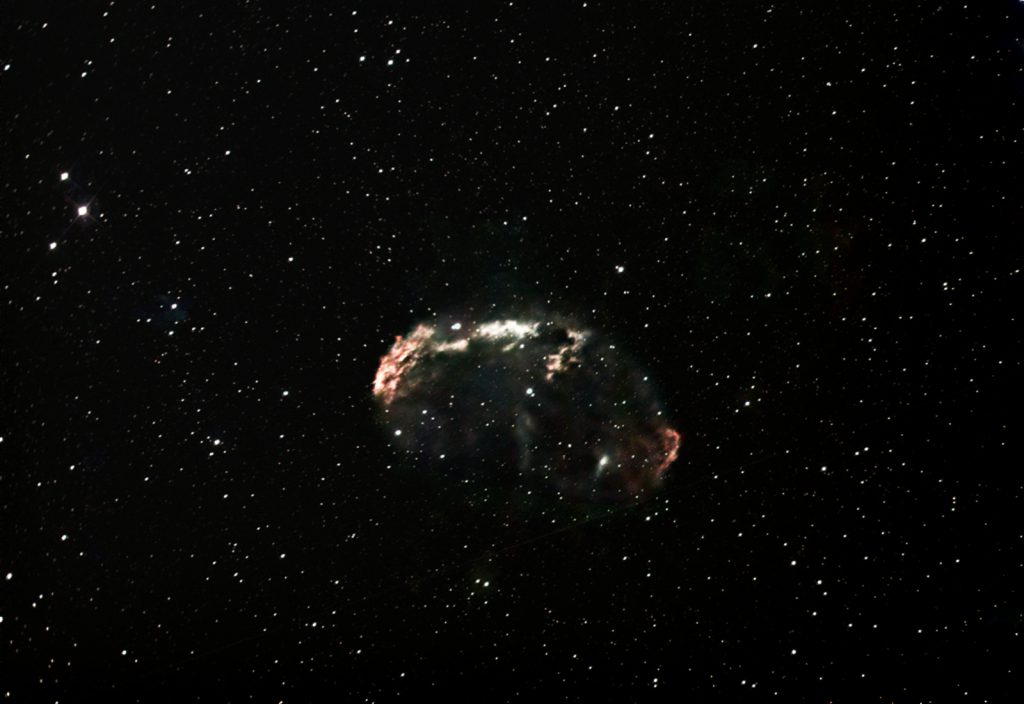
10.1″ f/4.5, Mallincam DS432cTEC with 0.5 focal reducer and Astronomik UHC filter
Exposure = 5-13-20 sec, Live Stacked frames = 15-31-24 (70 total), Gain = 70 of 250
Also known as Caldwell 27, the Crescent Nebula is about 5000 light years away, and 25 by 16 light years across. The bright Wolf-Rayet star at the center of the crescent-shape is the source of the nebula. Imaging the fainter parts of the crescent shape was difficult, for example the western side; to get the full crescent, the data in the image needed to be significantly stretched, making the brighter portions appear blown-out. There is a faint “ribbed” look on the interior portion of the nebula, giving it a very 3D appearance in this view. The faint extensions just above the bright portions make it look like it is smouldering.
North at 11 o’clock, East at 8 o’clock
NGC 6939 (2022-06-25)
NGC 6939
Flying Geese Cluster in Cepheus
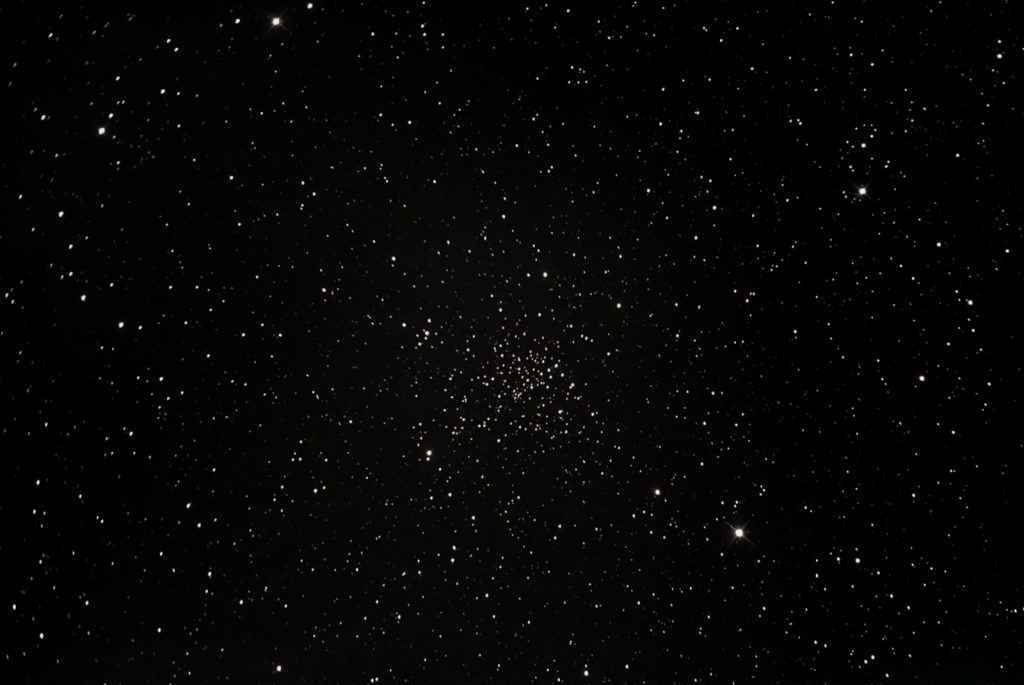
10.1″ f/4.5, Mallincam DS432cTEC with 0.5 focal reducer and Astronomik UHC filter
Exposure = 5 sec, Live Stacked frames = 20, Gain = 175 of 250
Also known as the Ghost Bush Cluster, NGC 6939 is a large, compact open cluster about 12 arcminutes across with a fairly even distribution of stars. As open clusters go, this one is pretty old, listed as being at least a billion years old. It is over 3800 light years away. The bright star to the lower right, HD 195085, is 7th magnitude. Flying Geese seems to have a somewhat triangular shape to it, maybe reminiscent of Canada Geese flying in a V-shape formation; can you see the direction the V is pointing in? This cluster is about 40 arcminutes south of the beautiful Fireworks Galaxy, NGC 6946.
North at 10 o’clock, East at 7 o’clock
NGC 6946 (2022-06-25)
NGC 6946
Fireworks Galaxy in Cygnus
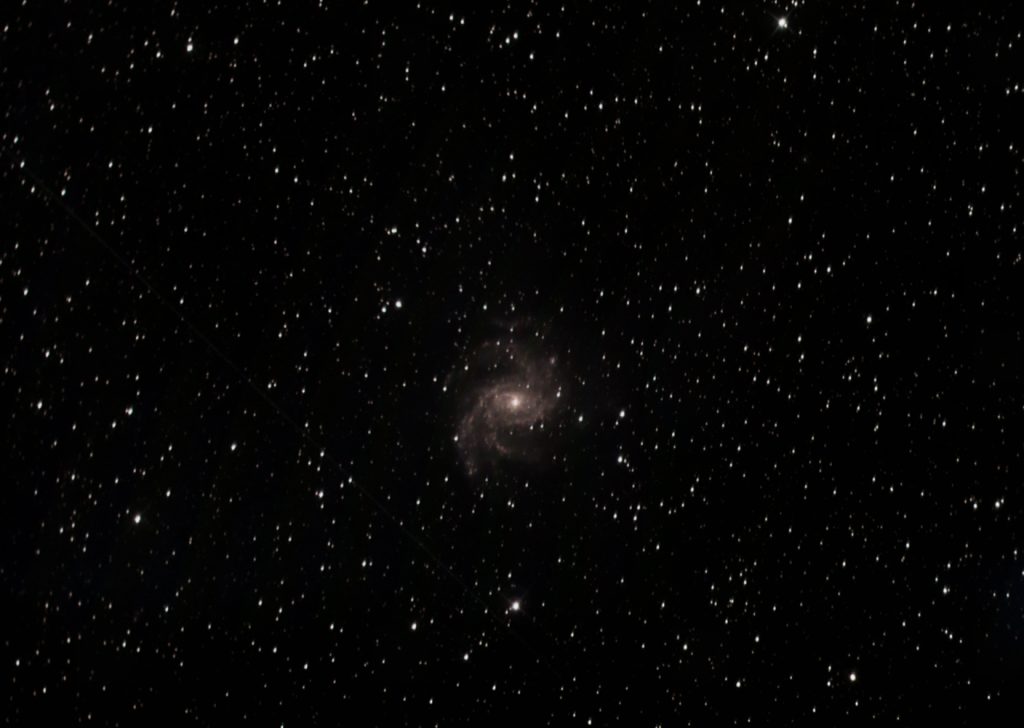
10.1″ f/4.5, Mallincam DS432cTEC with 0.5 focal reducer and Astronomik UHC filter
Exposure = 5-13-20 sec, Live Stacked frames = 15-30-25 (70 total), Gain = 70 of 250
The Fireworks Galaxy is a pretty, loose, spiral-armed structure that appears about 12 arcminutes across. Many clumps, knots, and dark lanes are visible in this view. The galaxy lies in the Coma-Sculptor Cloud of galaxies in the Virgo Supercluster, about 25 million light years away, just outside the confines of the Local Group. Physically it has about half the number of stars as the Milky Way (50 billion) and is about a third the size (40,000 light years). The galaxy makes a pretty pair in the sky with the open cluster NGC 6939, about 40 arcminutes to the northwest.
North at 10 o’clock, East at 7 o’clock
NGC 6960
NGC 6960
Western Veil in Cygnus
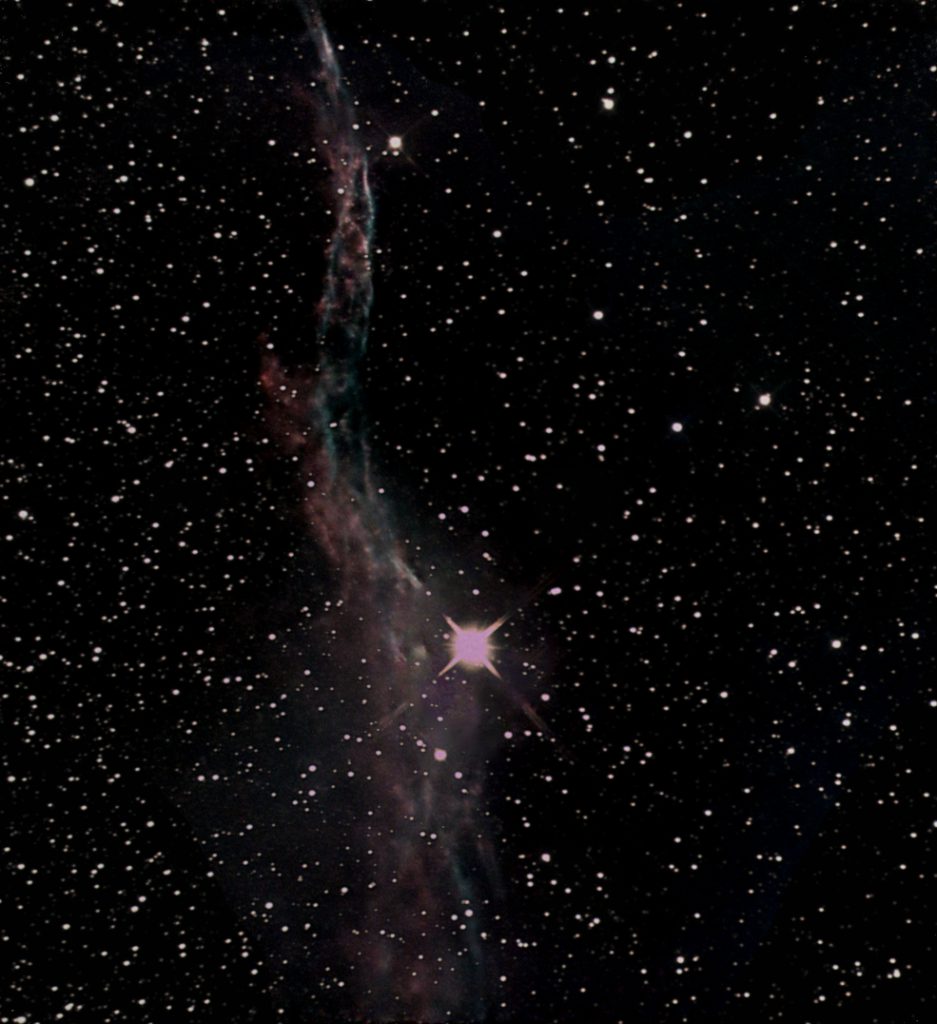
10.1” f/4.5, Mallincam DS432cTEC with 0.5 focal reducer
Exposure = 19 sec, White point = 255-201, Live Stacked frames = 30-40 (70 total), Gain = 13.5 of 250
The Western Veil, a spectacular large supernova remnant located a little over 3 degrees south of Aljanah (Epsilon Cygni). Only a portion of the nebula fits into the degree-wide field of view. The bright star in the image is 52 Cygni. The Veil is expanding westward (to the right) and according to Burnham’s is sweeping up material which is the reason there appears to be more stars to the left than to the right of it; darker areas right of the nebula can be seen, suggesting there is obscuring material there. The Veil is 2400 light years away and has a total radius of 65 light years.
North at 12 o’clock, East at 9 o’clock
NGC 6992/6995
NGC 6992/6995
Eastern Veil in Cygnus

10.1” f/4.5, Mallincam DS432cTEC with 0.5 focal reducer
Exposure = 15-19 sec, Live Stacked frames = 30-20 (50 total), Gain = 14 of 250
The Eastern Veil (NGC 6992) is the counterpart to the western portion of the Veil nebula, which together form the Cygnus Loop spanning roughly 3 degrees in south-eastern Cygnus. This image shows the southern portion of NGC 6992 (top two-thirds of the image here) together with the northern part of NGC 6995 (bottom third) which is also known as the “Network Nebula.” Lots of twists and turns and subtle wisps are visible. This nebula was difficult to locate in video mode on the Mallincam, virtually impossible to detect with eyepiece in Bortle 7/8 skies.
North at 12 o’clock, East at 9 o’clock
NGC 7000 (2022-07-22)
NGC 7000
North America Nebula in Cygnus

80mm f/5, Mallincam DS432cTEC with 0.5 focal reducer and Astronomik UHC filter
Exposure = 10-25 sec, Live Stacked frames = 15-25 (40 total), Gain = 44 of 250
This image was taken with the 80mm scope to get a wider view (2 x 3 degrees) and a better perspective on the North America shape, with the dark “Gulf of Mexico” in the center. The brighter orange ridge visible in “Central America” is the Cygnus Wall, the north-eastern (left) end of which is the portion that is visible at the bottom of this image. The southern end of the Pelican Nebula (IC 5070) is visible at top-right. There is a small cluster of stars above the “Gulf of Mexico,” approximately in the location of ‘Washington DC,” called NGC 6997 – various sources indicate this cluster is a couple of hundred light years beyond/behind the North America Nebula.
North at 10 o’clock, East at 7 o’clock
more images..
NGC 7023 (2022-06-25)
NGC 7023
Iris Nebula in Cepheus
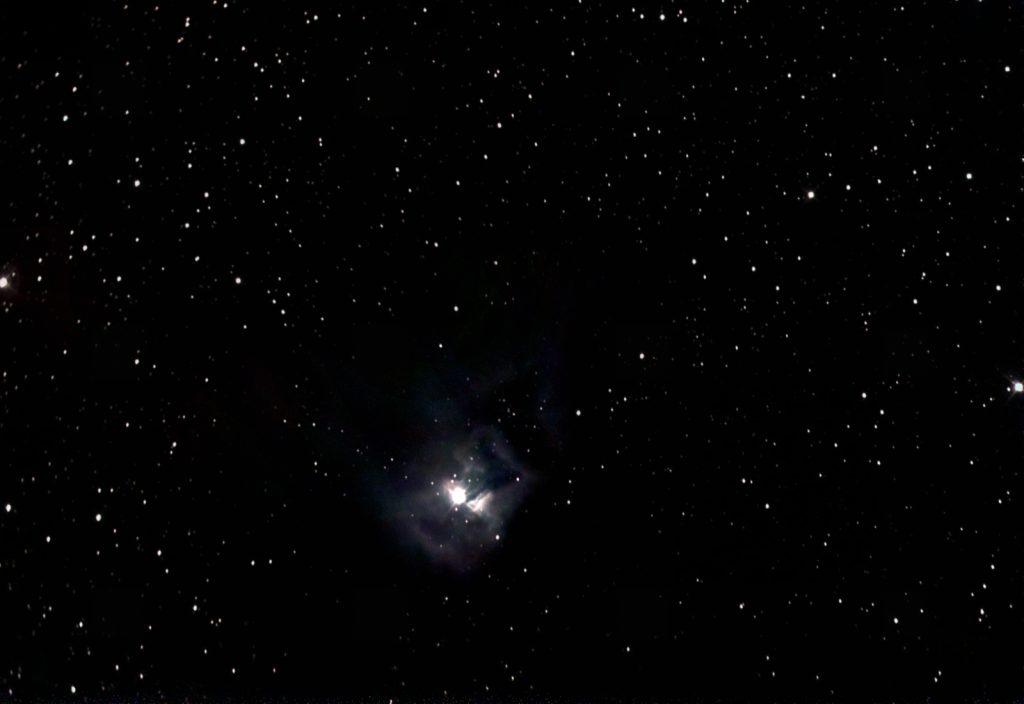
10.1″ f/4.5, Mallincam DS432cTEC with 0.5 focal reducer and Astronomik UHC filter
Exposure = 15 sec, Live Stacked frames = 30, Gain = 70 of 250
Also known as Caldwell 4, the Iris is a spectacular reflection nebula with a bright core and dimmer angular shapes surrounding the middle. The bottom (southern) portion of the bright core appears to be separate from the northern stellar part that contains a 7th magnitude star. The dimmer purple-blue-green surrounding nebula provides a fascinating reflection of light that gives the impression of rooms or hollow compartments, and provides a very 3D effect. Surrounding the entire nebula is another dark, unlit nebula that is obscuring stars in the background. In this view the Iris appears to be about 15 arcminutes in length when including the dimmer portions. It is listed as 6 light years across and is 1300 light years away.
North at 10 o’clock, East at 7 o’clock
NGC 7293 (2022-08-27)
NGC 7293
Helix Nebula in Aquarius
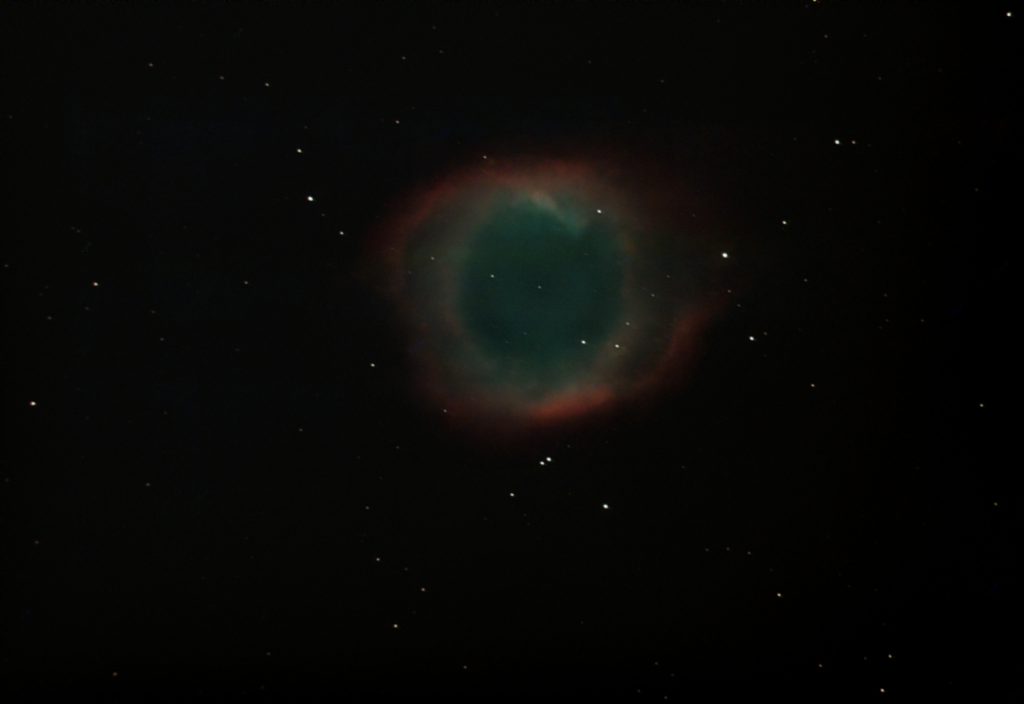
10.1″ f/4.5, Mallincam DS432cTEC with Astronomik UHC filter
Exposure = 10-15-20-29 sec, Live Stacked frames = 20-20-20-20-10 (90 total), WhitePoint = 255-255-255-255-220, Gain = 30 of 250
Also known as Caldwell 63 and the “Eye of God”, the Helix Nebula is a planetary nebula that spans approximately 15 arcminutes in this view. Extraordinary colours from blue-green oxygen through to deep red hydrogen and nitrogen are visible in the two overlapping rings that form the helix. The source of the expanding nebula, the bluish white dwarf central star visible here, is 13th magnitude. Finding the Helix proved to be fairly difficult, probably due to a combination of very low surface brightness and low altitude in the sky (about 24 degrees above horizon at the time) – the usual method of setting the Mallincam to a maximum exposure and gain in Video mode (5 seconds and 255 gain) did not work. After double-checking alignment with my Nexus DSC, doubling the exposure to 10 seconds made it appear out of nowhere. The Helix is the largest appearing and closest planetary nebula to us, 650 light years away, about 2.5 light years across, and is about 10,000 years old.
North at 1 o’clock, East at 10 o’clock
NGC 7380 (2022-07-08)
NGC 7380
Wizard Nebula in Cepheus
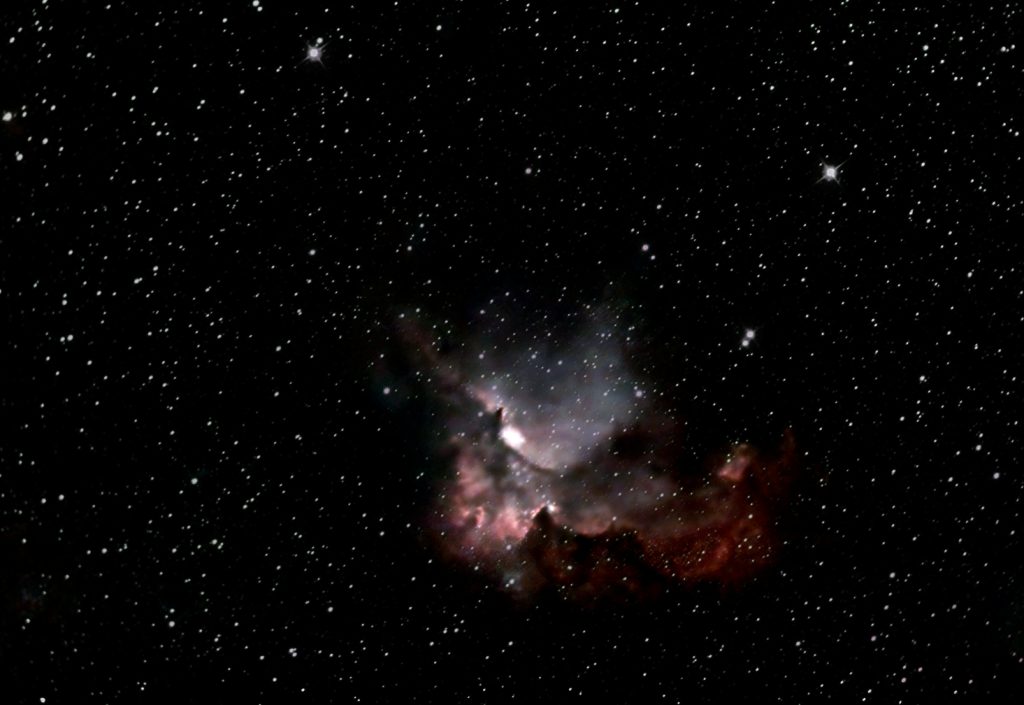
10.1″ f/4.5, Mallincam DS432cTEC with 0.5 focal reducer and Astronomik UHC filter
Exposure = 10-18-25 sec, Live Stacked frames = 20-20-60 (100 total), Gain = 50 of 250
The Wizard Nebula, also known as Harry Potter and the Golden Snitch, is a fairly difficult object to locate visually; I had the gain up to maximum and 5 second exposures to get a faint hint of it. With longer exposures and 100 frames the beauty of this nebula really becomes apparent; the image above though required substantial data stretching and some colour adjustment was also applied. Various complex hues of orange, red, and grey and lots of dark obscuring areas create the impression of a wizard’s hat, pointy nose, outstretched dark hand and a bright “snitch” in the form of HIP 112324, the bright magnitude 6 star toward the upper right. The red and orange wavy portions of the nebula at the bottom give the impression of flowing wizard robes.
North at 10 o’clock, East at 7 o’clock
8^)